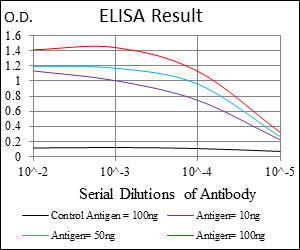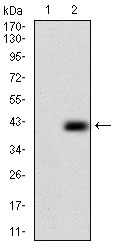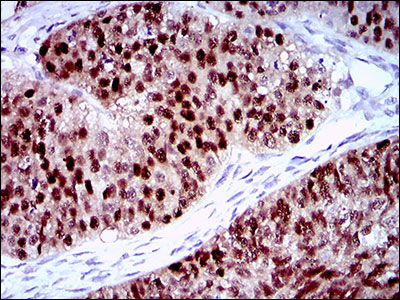PLAGL1 Antibody
Purified Mouse Monoclonal Antibody
- 产品详情
- 实验流程
- 背景知识
Application
| WB, IHC, E |
|---|---|
| Primary Accession | Q9UM63 |
| Reactivity | Human |
| Host | Mouse |
| Clonality | Monoclonal |
| Clone Names | 8D8C5 |
| Isotype | IgG1 |
| Calculated MW | 50819 Da |
| Description | This gene encodes a C2H2 zinc finger protein with transactivation and DNA-binding activities. It has been shown to have anti-proliferative properties, and thus thought to function as a tumor suppressor. In addition, overexpression of this gene during fetal development is believed to underlie the rare disorder, transient neonatal diabetes mellitus (TNDM). This gene is imprinted, with preferential expression of the paternal allele in many tissues, however, biallelic expression has been noted in peripheral blood leucocytes. A recent study reports that tissue-specific imprinting results from variable utilization of monoallelic and biallelic promoters. Many transcript variants differing in the 5' UTR and encoding two different isoforms, have been found for this gene. |
| Immunogen | Purified recombinant fragment of human PLAGL1 (AA: 118-222) expressed in E. Coli. |
| Formulation | Purified antibody in PBS with 0.05% sodium azide |
| Gene ID | 5325 |
|---|---|
| Other Names | Zinc finger protein PLAGL1, Lost on transformation 1, LOT-1, Pleiomorphic adenoma-like protein 1, Tumor suppressor ZAC, PLAGL1, LOT1, ZAC |
| Dilution | WB~~1/500 - 1/2000 IHC~~1/200 - 1/1000 E~~1/10000 |
| Storage | Maintain refrigerated at 2-8°C for up to 6 months. For long term storage store at -20°C in small aliquots to prevent freeze-thaw cycles. |
| Precautions | PLAGL1 Antibody is for research use only and not for use in diagnostic or therapeutic procedures. |
| Name | PLAGL1 |
|---|---|
| Synonyms | LOT1, ZAC |
| Function | Acts as a transcriptional activator (PubMed:9722527). Involved in the transcriptional regulation of type 1 receptor for pituitary adenylate cyclase-activating polypeptide. |
| Cellular Location | Nucleus |
For Research Use Only. Not For Use In Diagnostic Procedures.
Provided below are standard protocols that you may find useful for product applications.
BACKGROUND
The protein encoded by this gene associates with class II major histocompatibility complex (MHC) and is an important chaperone that regulates antigen presentation for immune response. It also serves as cell surface receptor for the cytokine macrophage migration inhibitory factor (MIF) which, when bound to the encoded protein, initiates survival pathways and cell proliferation. This protein also interacts with amyloid precursor protein (APP) and suppresses the production of amyloid beta (Abeta). Multiple alternatively spliced transcript variants encoding different isoforms have been identified. ;
REFERENCES
1. J Biomed Sci. 2012 Nov 15;19:95. 2. Exp Cell Res. 2011 Dec 10;317(20):2925-37.
终于等到您。ABCEPTA(百远生物)抗体产品。
点击下方“我要评价 ”按钮提交您的反馈信息,您的反馈和评价是我们最宝贵的财富之一,
我们将在1-3个工作日内处理您的反馈信息。
如有疑问,联系:0512-88856768 tech-china@abcepta.com.























 癌症的基本特征包括细胞增殖、血管生成、迁移、凋亡逃避机制和细胞永生等。找到癌症发生过程中这些通路的关键标记物和对应的抗体用于检测至关重要。
癌症的基本特征包括细胞增殖、血管生成、迁移、凋亡逃避机制和细胞永生等。找到癌症发生过程中这些通路的关键标记物和对应的抗体用于检测至关重要。 为您推荐一个泛素化位点预测神器——泛素化分析工具,可以为您的蛋白的泛素化位点作出预测和评分。
为您推荐一个泛素化位点预测神器——泛素化分析工具,可以为您的蛋白的泛素化位点作出预测和评分。 细胞自噬受体图形绘图工具为你的蛋白的细胞受体结合位点作出预测和评分,识别结合到自噬通路中的蛋白是非常重要的,便于让我们理解自噬在正常生理、病理过程中的作用,如发育、细胞分化、神经退化性疾病、压力条件下、感染和癌症。
细胞自噬受体图形绘图工具为你的蛋白的细胞受体结合位点作出预测和评分,识别结合到自噬通路中的蛋白是非常重要的,便于让我们理解自噬在正常生理、病理过程中的作用,如发育、细胞分化、神经退化性疾病、压力条件下、感染和癌症。









